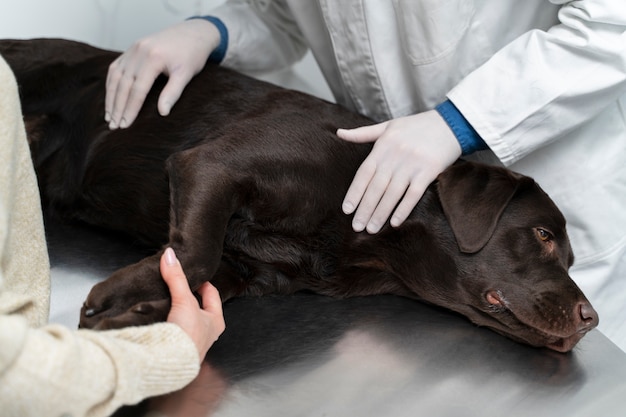Healing Hips: Canine Rehabilitation For Treating Hip Dysplasia In Dogs


Rehabilitation for Hip Dysplasia in Dogs
Hip dysplasia, a common orthopedic condition, can significantly impact a dog’s quality of life. This inherited disorder occurs when the hip joint doesn’t develop properly, leading to pain, discomfort, and reduced mobility. While hip dysplasia might seem like an insurmountable challenge, there’s a beacon of hope – canine rehabilitation. In this blog post, we’ll explore how tailored rehabilitation techniques can play a pivotal role in treating hip dysplasia, helping dogs regain their comfort, strength, and joy of movement.
Hip dysplasia occurs when the hip joint’s ball-and-socket structure is misaligned, causing friction and joint instability. This leads to inflammation, pain, and the gradual deterioration of the joint. Breeds of all sizes can be affected, with genetics playing a significant role. Dogs with hip dysplasia may display symptoms like limping, difficulty rising, and reluctance to engage in physical activities.
Canine rehabilitation offers a multi-faceted approach to addressing hip dysplasia, combining targeted exercises, pain management, and holistic therapies. Here’s how it plays a pivotal role in the treatment process:
- Exercises and Conditioning: Customized exercise programs are designed to strengthen the muscles surrounding the hip joint. These exercises help stabilize the joint, alleviate pain, and improve overall mobility. Low-impact exercises, such as controlled walks and gentle stretching, can gradually increase muscle strength and joint flexibility.
- Pulsed Electromagnetic Field Therapy (PEMF): PEMF therapy involves applying electromagnetic fields to the affected area. This non-invasive technique stimulates cell regeneration, reduces inflammation, promotes healing, providing pain relief and improving joint function.
- Shock Wave Therapy: Shock wave therapy uses acoustic waves to stimulate blood flow and tissue repair. It can help reduce pain, inflammation, and muscle tension, enhancing the dog’s comfort and mobility.
- Underwater Treadmill: Hydrotherapy in an underwater treadmill offers a low-impact environment for exercise. The buoyancy of water reduces joint stress while allowing the dog to engage in muscle-strengthening activities.
- Laser Treatments: Laser therapy uses focused light energy to penetrate tissues and stimulate healing. It reduces pain, inflammation, and muscle spasms, promoting faster recovery and improved joint function.
- Manual Therapy: Manual techniques like massage, joint mobilization, and passive range-of-motion exercises help maintain joint flexibility, alleviate muscle tension, and reduce stiffness. These therapies can improve overall mobility and comfort.
- Weight Management: Maintaining a healthy weight is crucial for dogs with hip dysplasia, as excess weight places additional stress on the affected joints. Rehabilitation professionals provide guidance on nutrition and exercise to support weight management.
Other benefits of Canine Rehabilitation for Hip Dysplasia are:
- Comprehensive Approach: Canine rehabilitation addresses various aspects of hip dysplasia, from pain management to muscle strengthening and joint flexibility.
- Customized Plans: Rehabilitation specialists create personalized treatment plans based on the dog’s individual condition, ensuring that the chosen techniques are effective and safe.
- Non-Invasive Techniques: The majority of rehabilitation methods for hip dysplasia are non-invasive, minimizing discomfort and promoting natural healing.
- Improved Comfort: Through pain relief, enhanced joint function, and muscle strengthening, rehabilitation helps dogs experience greater comfort and ease of movement.
- Long-Term Wellness: Canine rehabilitation supports dogs in their journey toward long-term comfort and mobility, even as they age.
Hip dysplasia may present significant challenges for dogs and their owners, but the journey to healing is paved with the promising path of canine rehabilitation. Through a combination of targeted exercises, pain management, and holistic therapies, dogs with hip dysplasia can experience improved comfort, mobility, and a better quality of life. Consulting a certified rehabilitation specialist and veterinary professional is essential in developing a comprehensive rehabilitation plan tailored to your dog’s unique needs. With the right care and support, your furry friend can overcome the obstacles posed by hip dysplasia and embark on a journey toward wellness, happiness, and vitality.




